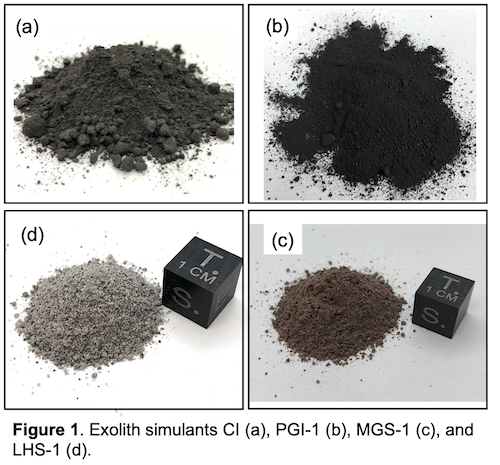Simulated Asteroid and Planetary Materials at the CLASS Exolith Lab
- University of Central Florida, Orlando, FL, United States of America
The Exolith Lab at The University of Central Florida’s Center for Lunar and Asteroid Surface Science (CLASS) produces high-mineralogical fidelity asteroid and planetary regolith simulants (several are pictured in Figure 1). Regolith simulants are used as analogs in scientific studies and in hardware development and testing for space exploration and in-situ resource utilization (ISRU) efforts. It is crucial that such simulants accurately replicate the mineral, chemical and physical properties of the simulated regoliths. Mineralogical fidelity is the foundation of our approach. For each simulant, we source individual minerals from industrial suppliers to reproduce the mineralogy and bulk chemistry of a reference material. We also control for particle size distribution, crushing the regolith simulant to a power law distribution or sieving to a specified distribution as requested.

Asteroid and Phobos Simulants
We offer a CI meteorite-based primitive asteroid simulant and have also developed CM and CR based simulants [1]. Volatile-rich asteroids are high-priority targets for ISRU efforts. The CI simulant scores highly in fidelity against reference materials in its mineralogy and bulk chemistry, grain and bulk density, magnetic properties, mechanical cobble strength, and patterns of volatile release [2]. Simulating the organic component of planetary materials is a challenge, as this component contains hazardous polycyclic aromatic hydrocarbons (PAHs). In our simulants, we instead use sub-bituminous coal as the organic component. Sub-bituminous coal has similar aromaticity and chemical composition to PAHs but is significantly less hazardous. Another challenge is sourcing the phyllosilicate components. CM mineralogies in particular contain the Fe-serpentine cronstedtite, which does not occur naturally on Earth in the commercial quantities needed for large scale simulant production. We substitute other phyllosilicates, including Mg-serpentines, opting for the lizardite polymorph rather than hazardous chrysotile.
We have recently developed two Phobos simulants for testing of hardware for the upcoming JAXA Martian Moons eXploration (MMX) mission, which includes a Phobos sample return objective. These simulants are PGI-1 (Phobos Giant Impact), based on the hypothesis that Phobos was formed by a giant impact with Mars, and PCA-1 (Phobos Captured Asteroid), based on the captured asteroid origin hypothesis. The PCA-1 recipe is adapted from our CI asteroid recipe. PGI-1 is CI mixed with a simplified Mars crust and mantle. In addition to our standard tests of bulk chemistry and particle size distribution, we measured the abrasivity, angle of repose, compressive strength, shear strength, cohesion, flowability, and hardness for both Phobos simulants. A paper on these results is in review. This is part of a larger effort to systematically characterize the physical properties of our simulants, including geotechnical properties that are of interest for spacecraft hardware development. We will make these results available to the community in the peer-reviewed literature.
Other Simulants
Exolith Lab also offers the following simulants:
- Lunar Highlands Simulant (LHS-1): Generic highlands soil with a particle size distribution matched to Apollo 16 samples.
- Lunar Mare Simulant (LMS-1): Generic mare soil with a particle size distribution matched to Apollo samples.
- Mars Global Simulant (MGS-1) and variations: Global basaltic Mars soil simulant based on Rocknest soil. Two variants (a sulfate-enriched version, MGS-1S, and a clay-enriched version, MGS-1C) were also developed for water-extraction studies.
- Jezero Delta Simulant (JEZ-1): Developed based on remote sensing of the Jezero delta soils that will be the target of the Mars 2020 Perseverance rover.
- DUST-Y: Physical silicate dust simulant with ~1-10 micron particles. Useful for fine dust mitigation studies.
About Exolith Lab
Exolith Lab is a not for profit extension of CLASS. Our objective is to provide high-mineralogical fidelity, safe planetary regolith simulants to the community at the cost of materials, labor, and facilities. We publicly document the development and recipes for the simulants so that they can serve as an open standard, for use and modification as needed. To order Exolith simulants or for more information, visit our website at https://sciences.ucf.edu/class/exolithlab/. There is also a Planetary Simulant Database available at https://simulantdb.com/.
References
How to cite: Landsman, Z. and Britt, D.: Simulated Asteroid and Planetary Materials at the CLASS Exolith Lab, Europlanet Science Congress 2020, online, 21 September–9 Oct 2020, EPSC2020-906, https://doi.org/10.5194/epsc2020-906, 2020

